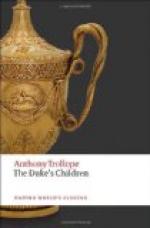The intention had been to take the horse round a portion of the outside of the course near to which his stable stood. A boy rode him and the groom and Tifto went with him. At a certain spot on their return Tifto had exclaimed that the horse was going lame in his off fore-foot. As to this exclamation the boy and two men were agreed. The boy was then made to dismount and run for Mr Pook; and as he started Tifto commenced to examine the horse’s foot. The boy saw him raise the off fore-leg. He himself had not found the horse lame under him, but had been so hustled and hurried out of the saddle by Tifto and the groom that he had not thought on that matter till he was questioned. So far the story told by Tifto and the groom was corroborated by the boy,—except as to the horse’s actual lameness. So far the story was believed by all men,—except in regard to the actual lameness. And so far it was true. Then, according to Tifto and the groom, the other foot was looked at, but nothing was seen. This other foot, the near fore-foot, was examined by the groom, who declared himself to be so flurried by the lameness of such a horse at such a time, that he hardly knew what he saw or what he did not see. At any rate then in his confusion he found no cause of lameness; but the horse was led into the stable as lame as at tree. Here Tifto found the nail inserted into the very cleft of the frog of the near fore-foot, and so inserted that he could not extract it till the farrier came. That the farrier had extracted the nail from the part of the foot indicated was certainly a fact.
Then there was the nail. Only those who were most peculiarly privileged were allowed to see the nail. But it was buzzed about the racing quarters that the head of the nail,—and old rusty, straight, and well-pointed nail,—bore on it the mark of a recent hammer. In answer to this it was alleged that the blacksmith in extracting the nail with his pincers, had of course operated on its head, had removed certain particles of rust, and might easily have given it the appearance of having been struck. But in answer to this the farrier, who was a sharp fellow, and quite beyond suspicion in the matter, declared that he had very particularly looked at the nail before he extracted it,—had looked at it with the feeling that something base might too probably have been done,—and that he was ready to swear that the clear mark on the head of the nail was there before he touched it. And then not in the stable, but lying under the little dung-heap away from the stable-door, there was found a small piece of broken iron bar, about a foot long, which might have answered for a hammer,—a rusty bit of iron; and amidst the rust of this there was found such traces as might have been left had it been used in striking such a nail. There were some who declared that neither on the nail nor on the iron could they see anything. And among these was the Major. But Mr Lupton brought a strong magnifying-glass to bear, and the world of examiners was satisfied that the marks were there.




